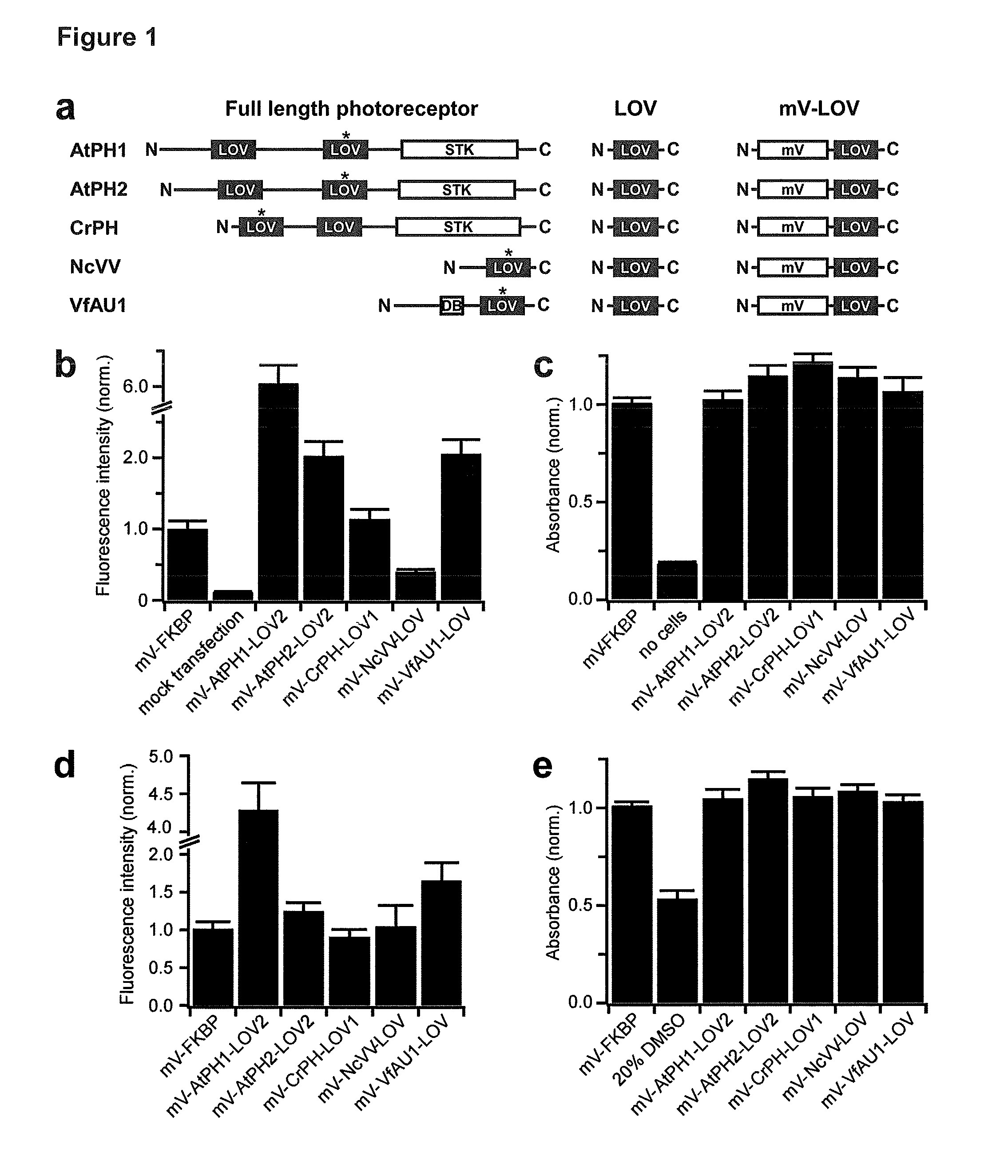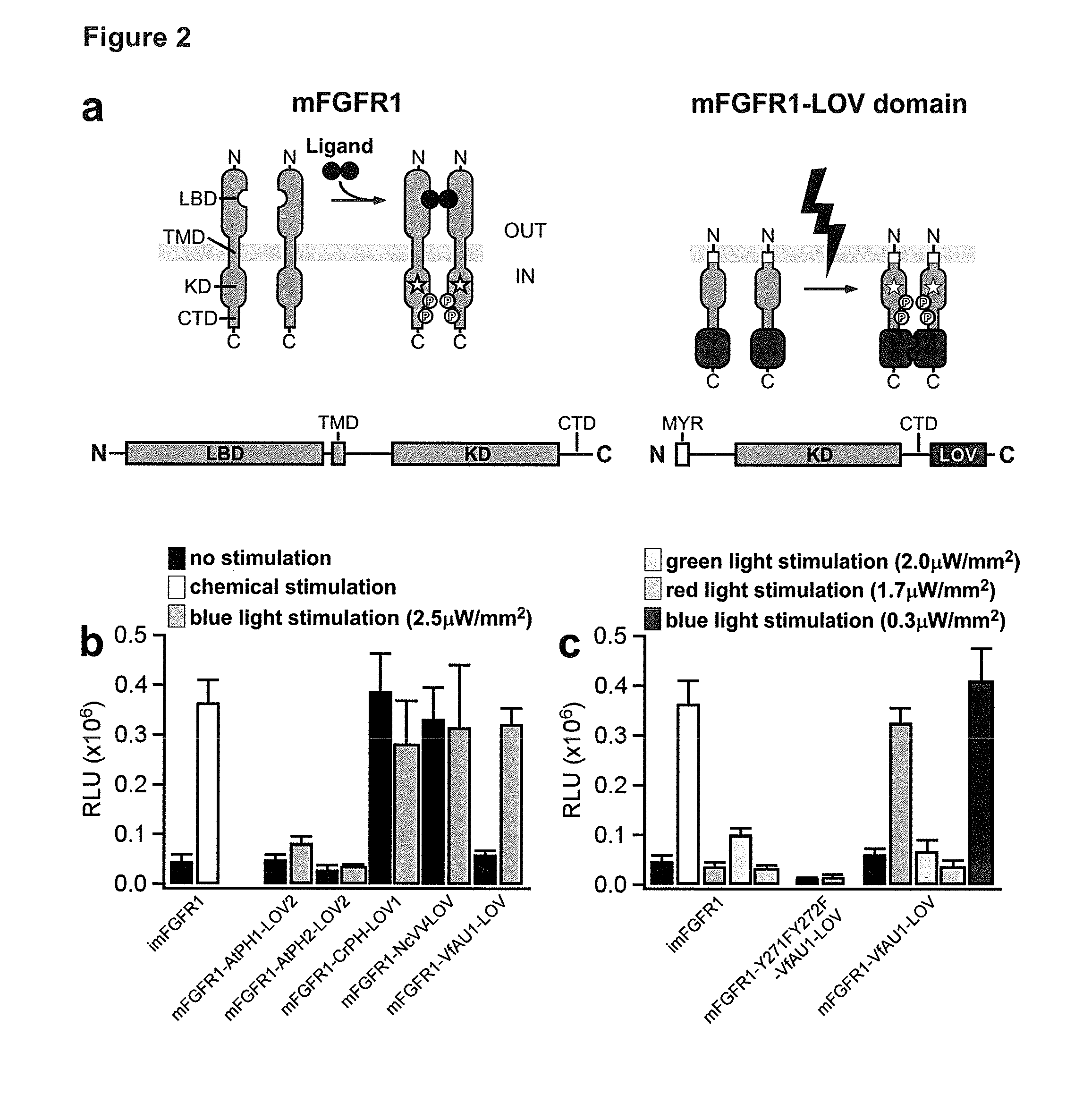Optically activated receptors
a receptor and optogenetic technology, applied in the field of optogenetics, can solve the problems of difficult setting, two genes required for expression of rtks and their associated signaling pathways, and the inability to optically control them, and achieve the effect of remarkable diversity
- Summary
- Abstract
- Description
- Claims
- Application Information
AI Technical Summary
Benefits of technology
Problems solved by technology
Method used
Image
Examples
example 1
[0329]As it was initially unclear which LOV domain will be suited for activation of a mammalian RTK, the inventors compiled an unbiased panel of diverse candidate LOV domains (one from fungi, two from algae and two from plants) (FIG. 1a and SEQ ID NO: 1-14).
TABLE 1Photophysical and equilibrium bindingparameters of LOV domains.EstimatedEstimated excitedNameKD (μM)state lifetime (s)3AtPH1-LOV2Dark: ~40Light: AtPH2-LOV2Dark: ~7Light: CrPH-LOV1Dark: ~2001 Light: NcVV-LOVDark: >10'000 Light: VfAU1-LOVDark: >300—Light: VfAU1-LOV2—~300 VfAU1-LOV2—WT: 480I28V (I472V): 601A triple exponential decay with lifetimes ranging from 20 to 800 s was observed.2LOV domains included C- and N-terminal extensions compared to VfAU1-LOV of this study.3Where necessary, published half life values (t½) were converted to lifetimes (τ = t½ / ln(2)) assuming a first order reaction.
[0330]For these domains, light-dependent changes in oligomerization state were previously reported (Katsura, 2009; Kaiserli, 2009; K...
example 2
[0340]The development and progression of cancer is frequently linked to mutations in RTKs or RTK overexpression, and many cancer cells respond to growth factors with increased proliferation, migration and epithelial-mesenchymal transition (EMT) (Metzner et al. 2011, Sakuma et al. 2012). To establish a cellular model of human cancer relevant to FGF / FGFR signaling, the inventors tested cells from different tumor entities for effects of FGF2, a prominent FGFR ligand. The inventors found that M38K cells (Kahlos et al. 1998) derived from malignant pleural mesothelioma responded to FGF with characteristic changes in cell behavior. To investigate whether Opto-FGFR1 allows controlling the behavior of these human tumor cells with light, the inventors virally delivered Opto-mFGFR1 into these cells and propagated cells with stable Opto-mFGFR1 expression. Stimulation with blue light resulted in rapid phosphorylation of Opto-mFGFR1 and ERK1 / 2, which returned to pre-stimulation levels within minu...
example 3
[0346]The inventors first identified a protein domain that undergoes homodimerization in response to red light (the light-sensing domain of the cyanobacterial phytochrome (PHY) CPH1 of Synechocystis PCC6803 (SyCP1-PHY)). The inventors then prepared fusion proteins where SyCP1-PHY was linked to the intracellular catalytic domain of murine FGFR1 (mFGFR1) or rat trkB (rtrkB) (FIGS. 10 and 11). The extracellular ligand-binding modules of mFGFR1 / rtrkB were omitted to obtain fusion proteins that are not responsive to native ligands. Cells expressing the fusion proteins should respond to red light with activation of signalling pathways characteristic for mFGFR1 / rtrkB. The inventors performed cell signalling experiments in a custom-built incubator that allows illumination of cells and tissues with light of defined intensity and colour (Materials and Methods). As in Example 1, the mitogen-activated protein kinase (MAPK) pathway was first examined.
[0347]It was found that the fusion proteins a...
PUM
| Property | Measurement | Unit |
|---|---|---|
| wavelength | aaaaa | aaaaa |
| wavelength | aaaaa | aaaaa |
| wavelength | aaaaa | aaaaa |
Abstract
Description
Claims
Application Information
 Login to View More
Login to View More - R&D
- Intellectual Property
- Life Sciences
- Materials
- Tech Scout
- Unparalleled Data Quality
- Higher Quality Content
- 60% Fewer Hallucinations
Browse by: Latest US Patents, China's latest patents, Technical Efficacy Thesaurus, Application Domain, Technology Topic, Popular Technical Reports.
© 2025 PatSnap. All rights reserved.Legal|Privacy policy|Modern Slavery Act Transparency Statement|Sitemap|About US| Contact US: help@patsnap.com



